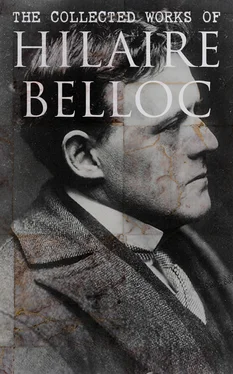8.It is worth remarking that Perponcher had been told by Wellington, when he first heard of Napoleon’s approach, to remain some miles off to the west at Nivelles. Wellington laboured, right up to the battle of Waterloo, under the fantastic impression that the French, or a considerable body of them, were, for some extraordinary reason, going to leave the Brussels road, go round westward and attack his right . He was, as might be expected of a defensive genius, nervous for his communications. Luckily for Wellington, Perponcher simply disobeyed these orders, left Nivelles before dawn, was at Quatre Bras before sunrise, and proceeded to act as we shall see above.
9.Or at the most sixteen.
10.This first division of the Guards consisted of the two brigades of Maitland and of Byng.
11.Let it be remembered, for instance, that Ziethen’s corps, which helped to turn the scale at Waterloo, two days later, only arrived, on the field of battle less than half an hour before sunset .
12.I have in this map numbered separate corps and units from one to ten, without giving them names. The units include the English cavalry and Dornberg’s brigade, with the Cumberland Hussars, the First, Second, Third, and Fifth Infantry Divisions, the corps of Brunswick, the Nassauers, and the Second and Third Netherlands Divisions. All of these ultimately reached Quatre Bras with the exception of the Second Infantry Division.
13.In which 15,000, as accurate statistics are totally lacking, and the whole thing is a matter of rough estimate, we may assign what proportion we will to killed, to wounded, and to prisoners respectively.
14.The reason he was thus ignorant of what had really happened to the Prussians was, that the officer who had been sent by the chief of the Prussian staff to the Duke after nightfall to inform him of the Prussian defeat had never arrived. That officer had been severely wounded on the way, and the message was not delivered.
15.There has arisen a discussion as to the whole nature of this retreat between the French authorities, who insist upon the close pursuit by their troops and the precipitate flight of the English rearguard, and the English authorities, who point out how slight were the losses of that rearguard, and how just was Wellington’s comment that the retreat, as a whole, was unmolested.
This dispute is solved, as are many disputes, by the consideration that each narrator is right from his point of view. The French pursuit was most vigorous, the English rearguard was very hard pressed indeed; but that rearguard was so well handled that it continually held its own, gave back as good as it got, and efficiently protected the unmolested retreat of the mass of the army.
16.“Dead” ground means ground in front of a position sheltered by its very steepness from the fire of the defence upon the summit. The ideal front for a defence conducted with firearms is not a very steep slope, but a long, slight, open and even one.
17.Almost exactly ten per cent.
18.It is from thirty to fifty feet above the spur on which he had just ranged his guns in front of the army, some twenty-five feet higher than the crest occupied a mile off by the allied army, and a few feet higher than the bare land somewhat more than four miles off, upon which Napoleon first discerned the arriving Prussians.
19.See map opposite title-page.
20.There is conflict of evidence as to how long the brigade was exposed to this terrible ordeal. It was slightly withdrawn at some moment, but what moment is doubtful.
21.The group marked “C” upon the coloured map. It was for the most part under the command of Milhaud, but the rear of it was under the command of Desnoettes.
22.See sketch opposite page 134.
23.This is the wood upon the extreme right hand of the coloured map.
24.In the model on p. 155 Plancenoit is not shown. It would be out of the model, nearer the spectator, behind Napoleon’s position at A, and between A and N.
25.The Guard as a whole had lain behind the French line in reserve all day upon the point marked D upon the coloured map.
26.Virtually, this advance in echelon had turned into four columns.
27.We may allow certainly 7000 prisoners and 30,000 killed and wounded, but that is a minimum. It is quite possible that another 3000 should be added to the prisoners and other 5000 to those who fell. The estimates differ so widely because the numerous desertions after the fall of the Empire make it very difficult to compare the remnant of the army with its original strength.
Table of Contents
Table of Contents
I. The Political Meaning of Malplaquet
II. The Siege of Tournai
III. The Manœuvring for Position
IV. The Preliminaries of the Battle
V. The Action
I
THE POLITICAL MEANING OF MALPLAQUET
Table of Contents
That political significance which we must seek in all military history, and without which that history cannot be accurate even upon its technical side, may be stated for the battle of Malplaquet in the following terms.
Louis XIV. succeeding to a cautious and constructive period in the national life of France, this in its turn succeeding to the long impotence of the religious wars, found at his orders when his long minority was ended a society not only eager and united, but beginning also to give forth the fruit due to three active generations of discussion and combat.
Every department of the national life manifested an extreme vitality, and, while the orderly and therefore convincing scheme of French culture imposed itself upon Western Europe, there followed in its wake the triumph of French arms; the king in that triumph nearly perfected a realm which would have had for its limits those of ancient Gaul.
It would be too long a matter to describe, even in general terms, the major issues depending upon Louis XIV.’s national ambitions and their success or failure.
In one aspect he stands for the maintenance of Catholic civilisation against the Separatist and dissolving forces of the Protestant North; in another he is the permanent antagonist of the Holy Roman Empire, or rather of the House of Austria, which had attained to a permanent hegemony therein. An extravagant judgment conceives his great successes as a menace to the corporate independence of Europe, or—upon the other view—as the opportunity for the founding of a real European unity.
But all these general considerations may, for the purposes of military history, be regarded in the single light of the final and decisive action which Louis XIV. took when he determined in the year 1701 to support the claims of his young grandson to the throne of Spain. This it was which excited against him a universal coalition, and acts following upon that main decision drew into the coalition the deciding factor of Great Britain.
The supremacy of French arms had endured in Europe for forty years when the Spanish policy was decided on. Louis was growing old. That financial exhaustion which almost invariably follows a generation of high national activity, and which is almost invariably masked by pompous outward state, was a reality already present though as yet undiscovered in the condition of France.
It was at the close of that year 1701 that the French king had determined upon a union of the two crowns of France and Spain in his own family. His forces occupied the Spanish Netherlands, which we now call the Kingdom of Belgium; others of his armies were spread along the Rhine, or were acting in Northern Italy—for the coalition at once began to make itself felt. Two men of genius combined in an exact agreement, the qualities of each complementing the defects of the other, to lead the main armies that were operating against the French. These men were Prince Eugene of Savoy (French by birth and training, a voluntary exile, and inspired throughout his life by a determination to avenge himself upon Louis XIV.), and the Englishman John Churchill, Duke of Marlborough.
Читать дальше












